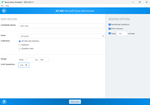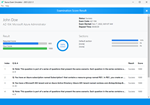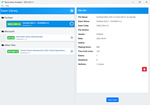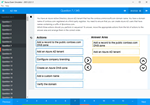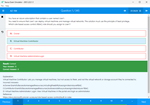Download CompTIA SecurityX Certification.CAS-005.VCEplus.2025-02-25.38q.tqb
| Vendor: | CompTIA |
| Exam Code: | CAS-005 |
| Exam Name: | CompTIA SecurityX Certification |
| Date: | Feb 25, 2025 |
| File Size: | 1 MB |
How to open TQB files?
Files with TQB (Taurus Question Bank) extension can be opened by Taurus Exam Studio.
Purchase
Coupon: TAURUSSIM_20OFF
Discount: 20%
Demo Questions
Question 1
A compliance officer is reviewing the data sovereignty laws in several countries where the organization has no presence Which of the following is the most likely reason for reviewing these laws?
- The organization is performing due diligence of potential tax issues.
- The organization has been subject to legal proceedings in countries where it has a presence.
- The organization is concerned with new regulatory enforcement in other countries
- The organization has suffered brand reputation damage from incorrect media coverage
Correct answer: C
Explanation:
Reviewing data sovereignty laws in countries where the organization has no presence is likely due to concerns about regulatory enforcement. Data sovereignty laws dictate how data can be stored, processed, and transferred across borders. Understanding these laws is crucial for compliance, especially if the organization handles data that may be subject to foreign regulations.A . The organization is performing due diligence of potential tax issues: This is less likely as tax issues are generally not directly related to data sovereignty laws.B . The organization has been subject to legal proceedings in countries where it has a presence: While possible, this does not explain the focus on countries where the organization has no presence.C . The organization is concerned with new regulatory enforcement in other countries: This is the most likely reason. New regulations could impact the organization's operations, especially if they involve data transfers or processing data from these countries.D . The organization has suffered brand reputation damage from incorrect media coverage: This is less relevant to the need for reviewing data sovereignty laws. CompTIA Security+ Study GuideGDPR and other global data protection regulations'Data Sovereignty: The Future of Data Protection?' by Mark Burdon Reviewing data sovereignty laws in countries where the organization has no presence is likely due to concerns about regulatory enforcement. Data sovereignty laws dictate how data can be stored, processed, and transferred across borders. Understanding these laws is crucial for compliance, especially if the organization handles data that may be subject to foreign regulations.
A . The organization is performing due diligence of potential tax issues: This is less likely as tax issues are generally not directly related to data sovereignty laws.
B . The organization has been subject to legal proceedings in countries where it has a presence: While possible, this does not explain the focus on countries where the organization has no presence.
C . The organization is concerned with new regulatory enforcement in other countries: This is the most likely reason. New regulations could impact the organization's operations, especially if they involve data transfers or processing data from these countries.
D . The organization has suffered brand reputation damage from incorrect media coverage: This is less relevant to the need for reviewing data sovereignty laws.
CompTIA Security+ Study Guide
GDPR and other global data protection regulations
'Data Sovereignty: The Future of Data Protection?' by Mark Burdon
Question 2
Which of the following is the main reason quantum computing advancements are leading companies and countries to deploy new encryption algorithms?
- Encryption systems based on large prime numbers will be vulnerable to exploitation
- Zero Trust security architectures will require homomorphic encryption.
- Perfect forward secrecy will prevent deployment of advanced firewall monitoring techniques
- Quantum computers will enable malicious actors to capture IP traffic in real time
Correct answer: A
Explanation:
Advancements in quantum computing pose a significant threat to current encryption systems, especially those based on the difficulty of factoring large prime numbers, such as RSA. Quantum computers have the potential to solve these problems exponentially faster than classical computers, making current cryptographic systems vulnerable.Why Large Prime Numbers are Vulnerable:Shor's Algorithm: Quantum computers can use Shor's algorithm to factorize large integers efficiently, which undermines the security of RSA encryption.Cryptographic Breakthrough: The ability to quickly factor large prime numbers means that encrypted data, which relies on the hardness of this mathematical problem, can be decrypted.Other options, while relevant, do not capture the primary reason for the shift towards new encryption algorithms:B . Zero Trust security architectures: While important, the shift to homomorphic encryption is not the main driver for new encryption algorithms.C . Perfect forward secrecy: It enhances security but is not the main reason for new encryption algorithms.D . Real-time IP traffic capture: Quantum computers pose a more significant threat to the underlying cryptographic algorithms than to the real-time capture of traffic.CompTIA SecurityX Study GuideNIST Special Publication 800-208, 'Recommendation for Stateful Hash-Based Signature Schemes''Quantum Computing and Cryptography,' MIT Technology Review Advancements in quantum computing pose a significant threat to current encryption systems, especially those based on the difficulty of factoring large prime numbers, such as RSA. Quantum computers have the potential to solve these problems exponentially faster than classical computers, making current cryptographic systems vulnerable.
Why Large Prime Numbers are Vulnerable:
Shor's Algorithm: Quantum computers can use Shor's algorithm to factorize large integers efficiently, which undermines the security of RSA encryption.
Cryptographic Breakthrough: The ability to quickly factor large prime numbers means that encrypted data, which relies on the hardness of this mathematical problem, can be decrypted.
Other options, while relevant, do not capture the primary reason for the shift towards new encryption algorithms:
B . Zero Trust security architectures: While important, the shift to homomorphic encryption is not the main driver for new encryption algorithms.
C . Perfect forward secrecy: It enhances security but is not the main reason for new encryption algorithms.
D . Real-time IP traffic capture: Quantum computers pose a more significant threat to the underlying cryptographic algorithms than to the real-time capture of traffic.
CompTIA SecurityX Study Guide
NIST Special Publication 800-208, 'Recommendation for Stateful Hash-Based Signature Schemes'
'Quantum Computing and Cryptography,' MIT Technology Review
Question 3
During the course of normal SOC operations, three anomalous events occurred and were flagged as potential IoCs. Evidence for each of these potential IoCs is provided.
INSTRUCTIONS
Review each of the events and select the appropriate analysis and remediation options for each IoC.
- See the complete solution below in Explanation
Correct answer: A
Explanation:
Analysis and Remediation Options for Each IoC:IoC 1:Evidence:Source: Apache_httpdType: DNSQDest: @10.1.1.1:53, @10.1.2.5Data: update.s.domain, CNAME 3a129sk219r9slmfkzzz000.s.domain, 108.158.253.253Analysis:Analysis: The service is attempting to resolve a malicious domain.Reason: The DNS queries and the nature of the CNAME resolution indicate that the service is trying to resolve potentially harmful domains, which is a common tactic used by malware to connect to command-and-control servers.Remediation:Remediation: Implement a blocklist for known malicious ports.Reason: Blocking known malicious domains at the DNS level prevents the resolution of harmful domains, thereby protecting the network from potential connections to malicious servers.IoC 2:Evidence:Src: 10.0.5.5Dst: 10.1.2.1, 10.1.2.2, 10.1.2.3, 10.1.2.4, 10.1.2.5Proto: IP_ICMPData: ECHOAction: DropAnalysis:Analysis: Someone is footprinting a network subnet.Reason: The repeated ICMP ECHO requests to different addresses within a subnet indicate that someone is scanning the network to discover active hosts, a common reconnaissance technique used by attackers.Remediation: Remediation: Block ping requests across the WAN interface.Reason: Blocking ICMP ECHO requests on the WAN interface can prevent attackers from using ping sweeps to gather information about the network topology and active devices.IoC 3:Evidence:Proxylog:GET /announce?info_hash=%01dff%27f%21%10%c5%wp%4e%1d%6f%63%3c%49%6d&peer_id%3dxJFSUploaded=0&downloaded=0&left=3767869&compact=1&ip=10.5.1.26&event=startedUser-Agent: RAZA 2.1.0.0Host: localhostConnection: Keep-AliveHTTP 200 OKAnalysis:Analysis: An employee is using P2P services to download files.Reason: The HTTP GET request with parameters related to a BitTorrent client indicates that the employee is using peer-to-peer (P2P) services, which can lead to unauthorized data transfer and potential security risks.Remediation:Remediation: Enforce endpoint controls on third-party software installations.Reason: By enforcing strict endpoint controls, you can prevent the installation and use of unauthorized software, such as P2P clients, thereby mitigating the risk of data leaks and other security threats associated with such applications.CompTIA Security+ Study Guide: This guide offers detailed explanations on identifying and mitigating various types of Indicators of Compromise (IoCs) and the corresponding analysis and remediation strategies.CompTIA Security+ Exam Objectives: These objectives cover key concepts in network security monitoring and incident response, providing guidelines on how to handle different types of security events.Security Operations Center (SOC) Best Practices: This resource outlines effective strategies for analyzing and responding to anomalous events within a SOC, including the use of blocklists, endpoint controls, and network configuration changes.By accurately analyzing the nature of each IoC and applying the appropriate remediation measures, the organization can effectively mitigate potential security threats and maintain a robust security posture. Analysis and Remediation Options for Each IoC:
IoC 1:
Evidence:
Source: Apache_httpd
Type: DNSQ
Dest: @10.1.1.1:53, @10.1.2.5
Data: update.s.domain, CNAME 3a129sk219r9slmfkzzz000.s.domain, 108.158.253.253
Analysis:
Analysis: The service is attempting to resolve a malicious domain.
Reason: The DNS queries and the nature of the CNAME resolution indicate that the service is trying to resolve potentially harmful domains, which is a common tactic used by malware to connect to command-and-control servers.
Remediation:
Remediation: Implement a blocklist for known malicious ports.
Reason: Blocking known malicious domains at the DNS level prevents the resolution of harmful domains, thereby protecting the network from potential connections to malicious servers.
IoC 2:
Evidence:
Src: 10.0.5.5
Dst: 10.1.2.1, 10.1.2.2, 10.1.2.3, 10.1.2.4, 10.1.2.5
Proto: IP_ICMP
Data: ECHO
Action: Drop
Analysis:
Analysis: Someone is footprinting a network subnet.
Reason: The repeated ICMP ECHO requests to different addresses within a subnet indicate that someone is scanning the network to discover active hosts, a common reconnaissance technique used by attackers.
Remediation:
Remediation: Block ping requests across the WAN interface.
Reason: Blocking ICMP ECHO requests on the WAN interface can prevent attackers from using ping sweeps to gather information about the network topology and active devices.
IoC 3:
Evidence:
Proxylog:
GET /announce?info_hash=%01dff%27f%21%10%c5%wp%4e%1d%6f%63%3c%49%6d&peer_id%3dxJFS
Uploaded=0&downloaded=0&left=3767869&compact=1&ip=10.5.1.26&event=started
User-Agent: RAZA 2.1.0.0
Host: localhost
Connection: Keep-Alive
HTTP 200 OK
Analysis:
Analysis: An employee is using P2P services to download files.
Reason: The HTTP GET request with parameters related to a BitTorrent client indicates that the employee is using peer-to-peer (P2P) services, which can lead to unauthorized data transfer and potential security risks.
Remediation:
Remediation: Enforce endpoint controls on third-party software installations.
Reason: By enforcing strict endpoint controls, you can prevent the installation and use of unauthorized software, such as P2P clients, thereby mitigating the risk of data leaks and other security threats associated with such applications.
CompTIA Security+ Study Guide: This guide offers detailed explanations on identifying and mitigating various types of Indicators of Compromise (IoCs) and the corresponding analysis and remediation strategies.
CompTIA Security+ Exam Objectives: These objectives cover key concepts in network security monitoring and incident response, providing guidelines on how to handle different types of security events.
Security Operations Center (SOC) Best Practices: This resource outlines effective strategies for analyzing and responding to anomalous events within a SOC, including the use of blocklists, endpoint controls, and network configuration changes.
By accurately analyzing the nature of each IoC and applying the appropriate remediation measures, the organization can effectively mitigate potential security threats and maintain a robust security posture.
Question 4
You are tasked with integrating a new B2B client application with an existing OAuth workflow that must meet the following requirements:
- The application does not need to know the users' credentials.
- An approval interaction between the users and the HTTP service must be orchestrated.
- The application must have limited access to users' data.
INSTRUCTIONS
Use the drop-down menus to select the action items for the appropriate locations. All placeholders must be filled.


- See the complete solution below in Explanation
Correct answer: A
Explanation:
Select the Action Items for the Appropriate Locations:Authorization Server:Action Item: Grant accessThe authorization server's role is to authenticate the user and then issue an authorization code or token that the client application can use to access resources. Granting access involves the server authenticating the resource owner and providing the necessary tokens for the client application.Resource Server:Action Item: Access issued tokensThe resource server is responsible for serving the resources requested by the client application. It must verify the issued tokens from the authorization server to ensure the client has the right permissions to access the requested data.B2B Client Application:Action Item: Authorize access to other applicationsThe B2B client application must handle the OAuth flow to authorize access on behalf of the user without requiring direct knowledge of the user's credentials. This includes obtaining authorization tokens from the authorization server and using them to request access to the resource server.DetailedOAuth 2.0 is designed to provide specific authorization flows for web applications, desktop applications, mobile phones, and living room devices. The integration involves multiple steps and components, including:Resource Owner (User):The user owns the data and resources that are being accessed.Client Application (B2B Client Application):Requests access to the resources controlled by the resource owner but does not directly handle the user's credentials. Instead, it uses tokens obtained through the OAuth flow.Authorization Server:Handles the authentication of the resource owner and issues the access tokens to the client application upon successful authentication.Resource Server:Hosts the resources that the client application wants to access. It verifies the access tokens issued by the authorization server before granting access to the resources.OAuth Workflow:The resource owner accesses the client application.The client application redirects the resource owner to the authorization server for authentication.The authorization server authenticates the resource owner and asks for consent to grant access to the client application.Upon consent, the authorization server issues an authorization code or token to the client application.The client application uses the authorization code or token to request access to the resources from the resource server.The resource server verifies the token with the authorization server and, if valid, grants access to the requested resources.CompTIA Security+ Study Guide: Provides comprehensive information on various authentication and authorization protocols, including OAuth.OAuth 2.0 Authorization Framework (RFC 6749): The official documentation detailing the OAuth 2.0 framework, its flows, and components.OAuth 2.0 Simplified: A book by Aaron Parecki that provides a detailed yet easy-to-understand explanation of the OAuth 2.0 protocol.By ensuring that each component in the OAuth workflow performs its designated role, the B2B client application can securely access the necessary resources without compromising user credentials, adhering to the principle of least privilege. Select the Action Items for the Appropriate Locations:
Authorization Server:
Action Item: Grant access
The authorization server's role is to authenticate the user and then issue an authorization code or token that the client application can use to access resources. Granting access involves the server authenticating the resource owner and providing the necessary tokens for the client application.
Resource Server:
Action Item: Access issued tokens
The resource server is responsible for serving the resources requested by the client application. It must verify the issued tokens from the authorization server to ensure the client has the right permissions to access the requested data.
B2B Client Application:
Action Item: Authorize access to other applications
The B2B client application must handle the OAuth flow to authorize access on behalf of the user without requiring direct knowledge of the user's credentials. This includes obtaining authorization tokens from the authorization server and using them to request access to the resource server.
Detailed
OAuth 2.0 is designed to provide specific authorization flows for web applications, desktop applications, mobile phones, and living room devices. The integration involves multiple steps and components, including:
Resource Owner (User):
The user owns the data and resources that are being accessed.
Client Application (B2B Client Application):
Requests access to the resources controlled by the resource owner but does not directly handle the user's credentials. Instead, it uses tokens obtained through the OAuth flow.
Authorization Server:
Handles the authentication of the resource owner and issues the access tokens to the client application upon successful authentication.
Resource Server:
Hosts the resources that the client application wants to access. It verifies the access tokens issued by the authorization server before granting access to the resources.
OAuth Workflow:
The resource owner accesses the client application.
The client application redirects the resource owner to the authorization server for authentication.
The authorization server authenticates the resource owner and asks for consent to grant access to the client application.
Upon consent, the authorization server issues an authorization code or token to the client application.
The client application uses the authorization code or token to request access to the resources from the resource server.
The resource server verifies the token with the authorization server and, if valid, grants access to the requested resources.
CompTIA Security+ Study Guide: Provides comprehensive information on various authentication and authorization protocols, including OAuth.
OAuth 2.0 Authorization Framework (RFC 6749): The official documentation detailing the OAuth 2.0 framework, its flows, and components.
OAuth 2.0 Simplified: A book by Aaron Parecki that provides a detailed yet easy-to-understand explanation of the OAuth 2.0 protocol.
By ensuring that each component in the OAuth workflow performs its designated role, the B2B client application can securely access the necessary resources without compromising user credentials, adhering to the principle of least privilege.
Question 5
A security analyst wants to use lessons learned from a poor incident response to reduce dwell lime in the future The analyst is using the following data points

Which of the following would the analyst most likely recommend?
- Adjusting the SIEM to alert on attempts to visit phishing sites
- Allowing TRACE method traffic to enable better log correlation
- Enabling alerting on all suspicious administrator behavior
- utilizing allow lists on the WAF for all users using GFT methods
Correct answer: C
Explanation:
In the context of improving incident response and reducing dwell time, the security analyst needs to focus on proactive measures that can quickly detect and alert on potential security breaches. Here's a detailed analysis of the options provided:A . Adjusting the SIEM to alert on attempts to visit phishing sites: While this is a useful measure to prevent phishing attacks, it primarily addresses external threats and doesn't directly impact dwell time reduction, which focuses on the time a threat remains undetected within a network.B . Allowing TRACE method traffic to enable better log correlation: The TRACE method in HTTP is used for debugging purposes, but enabling it can introduce security vulnerabilities. It's not typically recommended for enhancing security monitoring or incident response.C . Enabling alerting on all suspicious administrator behavior: This option directly targets the potential misuse of administrator accounts, which are often high-value targets for attackers. By monitoring and alerting on suspicious activities from admin accounts, the organization can quickly identify and respond to potential breaches, thereby reducing dwell time significantly. Suspicious behavior could include unusual login times, access to sensitive data not usually accessed by the admin, or any deviation from normal behavior patterns. This proactive monitoring is crucial for quick detection and response, aligning well with best practices in incident response.D . Utilizing allow lists on the WAF for all users using GET methods: This measure is aimed at restricting access based on allowed lists, which can be effective in preventing unauthorized access but doesn't specifically address the need for quick detection and response to internal threats.CompTIA SecurityX Study Guide: Emphasizes the importance of monitoring and alerting on admin activities as part of a robust incident response plan.NIST Special Publication 800-61 Revision 2, 'Computer Security Incident Handling Guide': Highlights best practices for incident response, including the importance of detecting and responding to suspicious activities quickly.'Incident Response & Computer Forensics' by Jason T. Luttgens, Matthew Pepe, and Kevin Mandia: Discusses techniques for reducing dwell time through effective monitoring and alerting mechanisms, particularly focusing on privileged account activities.By focusing on enabling alerting for suspicious administrator behavior, the security analyst addresses a critical area that can help reduce the time a threat goes undetected, thereby improving the overall security posture of the organization.Top of FormBottom of Form In the context of improving incident response and reducing dwell time, the security analyst needs to focus on proactive measures that can quickly detect and alert on potential security breaches. Here's a detailed analysis of the options provided:
A . Adjusting the SIEM to alert on attempts to visit phishing sites: While this is a useful measure to prevent phishing attacks, it primarily addresses external threats and doesn't directly impact dwell time reduction, which focuses on the time a threat remains undetected within a network.
B . Allowing TRACE method traffic to enable better log correlation: The TRACE method in HTTP is used for debugging purposes, but enabling it can introduce security vulnerabilities. It's not typically recommended for enhancing security monitoring or incident response.
C . Enabling alerting on all suspicious administrator behavior: This option directly targets the potential misuse of administrator accounts, which are often high-value targets for attackers. By monitoring and alerting on suspicious activities from admin accounts, the organization can quickly identify and respond to potential breaches, thereby reducing dwell time significantly. Suspicious behavior could include unusual login times, access to sensitive data not usually accessed by the admin, or any deviation from normal behavior patterns. This proactive monitoring is crucial for quick detection and response, aligning well with best practices in incident response.
D . Utilizing allow lists on the WAF for all users using GET methods: This measure is aimed at restricting access based on allowed lists, which can be effective in preventing unauthorized access but doesn't specifically address the need for quick detection and response to internal threats.
CompTIA SecurityX Study Guide: Emphasizes the importance of monitoring and alerting on admin activities as part of a robust incident response plan.
NIST Special Publication 800-61 Revision 2, 'Computer Security Incident Handling Guide': Highlights best practices for incident response, including the importance of detecting and responding to suspicious activities quickly.
'Incident Response & Computer Forensics' by Jason T. Luttgens, Matthew Pepe, and Kevin Mandia: Discusses techniques for reducing dwell time through effective monitoring and alerting mechanisms, particularly focusing on privileged account activities.
By focusing on enabling alerting for suspicious administrator behavior, the security analyst addresses a critical area that can help reduce the time a threat goes undetected, thereby improving the overall security posture of the organization.
Top of Form
Bottom of Form
Question 6
An organization mat performs real-time financial processing is implementing a new backup solution Given the following business requirements?
- The backup solution must reduce the risk for potential backup compromise
- The backup solution must be resilient to a ransomware attack.
- The time to restore from backups is less important than the backup data integrity
- Multiple copies of production data must be maintained
Which of the following backup strategies best meets these requirement?
- Creating a secondary, immutable storage array and updating it with live data on a continuous basis
- Utilizing two connected storage arrays and ensuring the arrays constantly sync
- Enabling remote journaling on the databases to ensure real-time transactions are mirrored
- Setting up antitempering on the databases to ensure data cannot be changed unintentionally
Correct answer: A
Explanation:
A . Creating a secondary, immutable storage array and updating it with live data on a continuous basis: An immutable storage array ensures that data, once written, cannot be altered or deleted. This greatly reduces the risk of backup compromise and provides resilience against ransomware attacks, as the ransomware cannot modify or delete the backup data. Maintaining multiple copies of production data with an immutable storage solution ensures data integrity and compliance with the requirement for multiple copies.Other options:B . Utilizing two connected storage arrays and ensuring the arrays constantly sync: While this ensures data redundancy, it does not provide protection against ransomware attacks, as both arrays could be compromised simultaneously.C . Enabling remote journaling on the databases: This ensures real-time transaction mirroring but does not address the requirement for reducing the risk of backup compromise or resilience to ransomware.D . Setting up anti-tampering on the databases: While this helps ensure data integrity, it does not provide a comprehensive backup solution that meets all the specified requirements.CompTIA Security+ Study GuideNIST SP 800-209, 'Security Guidelines for Storage Infrastructure''Immutable Backup Architecture' by Veeam A . Creating a secondary, immutable storage array and updating it with live data on a continuous basis: An immutable storage array ensures that data, once written, cannot be altered or deleted. This greatly reduces the risk of backup compromise and provides resilience against ransomware attacks, as the ransomware cannot modify or delete the backup data. Maintaining multiple copies of production data with an immutable storage solution ensures data integrity and compliance with the requirement for multiple copies.
Other options:
B . Utilizing two connected storage arrays and ensuring the arrays constantly sync: While this ensures data redundancy, it does not provide protection against ransomware attacks, as both arrays could be compromised simultaneously.
C . Enabling remote journaling on the databases: This ensures real-time transaction mirroring but does not address the requirement for reducing the risk of backup compromise or resilience to ransomware.
D . Setting up anti-tampering on the databases: While this helps ensure data integrity, it does not provide a comprehensive backup solution that meets all the specified requirements.
CompTIA Security+ Study Guide
NIST SP 800-209, 'Security Guidelines for Storage Infrastructure'
'Immutable Backup Architecture' by Veeam
Question 7
During a forensic review of a cybersecurity incident, a security engineer collected a portion of the payload used by an attacker on a comprised web server Given the following portion of the code:

Which of the following best describes this incident?
- XSRF attack
- Command injection
- Stored XSS
- SQL injection
Correct answer: C
Explanation:
The provided code snippet shows a script that captures the user's cookies and sends them to a remote server. This type of attack is characteristic of Cross-Site Scripting (XSS), specifically stored XSS, where the malicious script is stored on the target server (e.g., in a database) and executed in the context of users who visit the infected web page.A . XSRF (Cross-Site Request Forgery) attack: This involves tricking the user into performing actions on a different site without their knowledge but does not involve stealing cookies via script injection.B . Command injection: This involves executing arbitrary commands on the host operating system, which is not relevant to the given JavaScript code.C . Stored XSS: The provided code snippet matches the pattern of a stored XSS attack, where the script is injected into a web page, and when users visit the page, the script executes and sends the user's cookies to the attacker's server.D . SQL injection: This involves injecting malicious SQL queries into the database and is unrelated to the given JavaScript code.CompTIA Security+ Study GuideOWASP (Open Web Application Security Project) guidelines on XSS'The Web Application Hacker's Handbook' by Dafydd Stuttard and Marcus Pinto The provided code snippet shows a script that captures the user's cookies and sends them to a remote server. This type of attack is characteristic of Cross-Site Scripting (XSS), specifically stored XSS, where the malicious script is stored on the target server (e.g., in a database) and executed in the context of users who visit the infected web page.
A . XSRF (Cross-Site Request Forgery) attack: This involves tricking the user into performing actions on a different site without their knowledge but does not involve stealing cookies via script injection.
B . Command injection: This involves executing arbitrary commands on the host operating system, which is not relevant to the given JavaScript code.
C . Stored XSS: The provided code snippet matches the pattern of a stored XSS attack, where the script is injected into a web page, and when users visit the page, the script executes and sends the user's cookies to the attacker's server.
D . SQL injection: This involves injecting malicious SQL queries into the database and is unrelated to the given JavaScript code.
CompTIA Security+ Study Guide
OWASP (Open Web Application Security Project) guidelines on XSS
'The Web Application Hacker's Handbook' by Dafydd Stuttard and Marcus Pinto
Question 8
A security architect for a global organization with a distributed workforce recently received funding lo deploy a CASB solution Which of the following most likely explains the choice to use a proxy-based CASB?
- The capability to block unapproved applications and services is possible
- Privacy compliance obligations are bypassed when using a user-based deployment.
- Protecting and regularly rotating API secret keys requires a significant time commitment
- Corporate devices cannot receive certificates when not connected to on-premises devices
Correct answer: A
Explanation:
A proxy-based Cloud Access Security Broker (CASB) is chosen primarily for its ability to block unapproved applications and services. Here's why:Application and Service Control: Proxy-based CASBs can monitor and control the use of applications and services by inspecting traffic as it passes through the proxy. This allows the organization to enforce policies that block unapproved applications and services, ensuring compliance with security policies.Visibility and Monitoring: By routing traffic through the proxy, the CASB can provide detailed visibility into user activities and data flows, enabling better monitoring and threat detection.Real-Time Protection: Proxy-based CASBs can provide real-time protection against threats by analyzing and controlling traffic before it reaches the end user, thus preventing the use of risky applications and services.CompTIA Security+ SY0-601 Study Guide by Mike Chapple and David SeidlNIST Special Publication 800-125: Guide to Security for Full Virtualization TechnologiesGartner CASB Market Guide A proxy-based Cloud Access Security Broker (CASB) is chosen primarily for its ability to block unapproved applications and services. Here's why:
Application and Service Control: Proxy-based CASBs can monitor and control the use of applications and services by inspecting traffic as it passes through the proxy. This allows the organization to enforce policies that block unapproved applications and services, ensuring compliance with security policies.
Visibility and Monitoring: By routing traffic through the proxy, the CASB can provide detailed visibility into user activities and data flows, enabling better monitoring and threat detection.
Real-Time Protection: Proxy-based CASBs can provide real-time protection against threats by analyzing and controlling traffic before it reaches the end user, thus preventing the use of risky applications and services.
CompTIA Security+ SY0-601 Study Guide by Mike Chapple and David Seidl
NIST Special Publication 800-125: Guide to Security for Full Virtualization Technologies
Gartner CASB Market Guide
Question 9
A company's security policy states that any publicly available server must be patched within 12 hours after a patch is released A recent llS zero-day vulnerability was discovered that affects all versions of the Windows Server OS:

Which of the following hosts should a security analyst patch first once a patch is available?
- 1
- 2
- 3
- 4
- 5
- 6
Correct answer: A
Explanation:
Based on the security policy that any publicly available server must be patched within 12 hours after a patch is released, the security analyst should patch Host 1 first. Here's why:Public Availability: Host 1 is externally available, making it accessible from the internet. Publicly available servers are at higher risk of being targeted by attackers, especially when a zero-day vulnerability is known.Exposure to Threats: Host 1 has IIS installed and is publicly accessible, increasing its exposure to potential exploitation. Patching this host first reduces the risk of a successful attack.Prioritization of Critical Assets: According to best practices, assets that are exposed to higher risks should be prioritized for patching to mitigate potential threats promptly.CompTIA Security+ SY0-601 Study Guide by Mike Chapple and David SeidlNIST Special Publication 800-40: Guide to Enterprise Patch Management TechnologiesCIS Controls: Control 3 - Continuous Vulnerability Management Based on the security policy that any publicly available server must be patched within 12 hours after a patch is released, the security analyst should patch Host 1 first. Here's why:
Public Availability: Host 1 is externally available, making it accessible from the internet. Publicly available servers are at higher risk of being targeted by attackers, especially when a zero-day vulnerability is known.
Exposure to Threats: Host 1 has IIS installed and is publicly accessible, increasing its exposure to potential exploitation. Patching this host first reduces the risk of a successful attack.
Prioritization of Critical Assets: According to best practices, assets that are exposed to higher risks should be prioritized for patching to mitigate potential threats promptly.
CompTIA Security+ SY0-601 Study Guide by Mike Chapple and David Seidl
NIST Special Publication 800-40: Guide to Enterprise Patch Management Technologies
CIS Controls: Control 3 - Continuous Vulnerability Management
Question 10
A security review revealed that not all of the client proxy traffic is being captured. Which of the following architectural changes best enables the capture of traffic for analysis?
- Adding an additional proxy server to each segmented VLAN
- Setting up a reverse proxy for client logging at the gateway
- Configuring a span port on the perimeter firewall to ingest logs
- Enabling client device logging and system event auditing
Correct answer: C
Explanation:
Configuring a span port on the perimeter firewall to ingest logs is the best architectural change to ensure that all client proxy traffic is captured for analysis. Here's why:Comprehensive Traffic Capture: A span port (or mirror port) on the perimeter firewall can capture all inbound and outbound traffic, including traffic that might bypass the proxy. This ensures that all network traffic is available for analysis.Centralized Logging: By capturing logs at the perimeter firewall, the organization can centralize logging and analysis, making it easier to detect and investigate anomalies.Minimal Disruption: Implementing a span port is a non-intrusive method that does not require significant changes to the network architecture, thus minimizing disruption to existing services.CompTIA Security+ SY0-601 Study Guide by Mike Chapple and David SeidlNIST Special Publication 800-92: Guide to Computer Security Log ManagementOWASP Logging Cheat Sheet Configuring a span port on the perimeter firewall to ingest logs is the best architectural change to ensure that all client proxy traffic is captured for analysis. Here's why:
Comprehensive Traffic Capture: A span port (or mirror port) on the perimeter firewall can capture all inbound and outbound traffic, including traffic that might bypass the proxy. This ensures that all network traffic is available for analysis.
Centralized Logging: By capturing logs at the perimeter firewall, the organization can centralize logging and analysis, making it easier to detect and investigate anomalies.
Minimal Disruption: Implementing a span port is a non-intrusive method that does not require significant changes to the network architecture, thus minimizing disruption to existing services.
CompTIA Security+ SY0-601 Study Guide by Mike Chapple and David Seidl
NIST Special Publication 800-92: Guide to Computer Security Log Management
OWASP Logging Cheat Sheet
HOW TO OPEN VCE FILES
Use VCE Exam Simulator to open VCE files
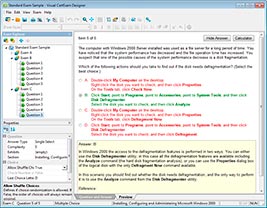
HOW TO OPEN VCEX FILES
Use ProfExam Simulator to open VCEX files
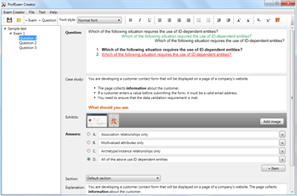
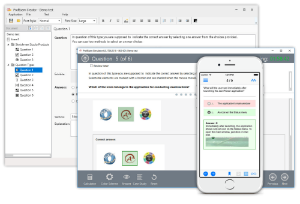
ProfExam at a 20% markdown
You have the opportunity to purchase ProfExam at a 20% reduced price
Get Now!